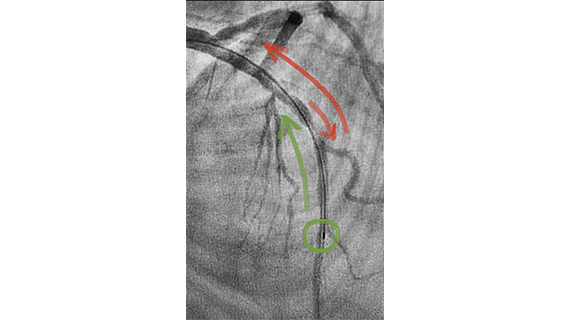OCT conundrum during PCI
#CardioTwitterCase originally published on Twitter
How did one coronary lesion become three lesions by OCT?
This case was originally published on Twitter by @RSohnMD
Case description
Coronary imaging using IVUS or OCT is essential for optimizing percutaneous coronary intervention (PCI). However, operators should always verify that the images obtained reflect reality. So, if findings are discrepant with angiography, consider artifact.
This is an 85-year-old man with crescendo angina culminating in NSTEMI. Coronary angiography was performed, which revealed a very focal high-grade stenosis of the mid-LAD (Video 1).
In preparation for PCI, we performed OCT pullback to assess vessel morphology (Video 2).
To our surprise, this showed 3 sequential high-grade stenoses despite no such finding by angiography.
Upon further inspection of the OCT pullback captured by fluoroscopy, we noticed abnormal motion of the OCT lens shortly after crossing the lesion (green circle & arrow, Figure 1). We determined that vigorous injection of contrast caused the entire OCT catheter to jump forward, approximately 10 mm before resuming its pullback (red arrows, Figure 1). Therefore, the OCT lens crosses the same lesion a total of three times.

Figure 1
See Video 3 for the angiographic pullback in slow-motion.
Final remarks
In conclusion, if coronary imaging contradicts angiographic findings, consider artifact and seek out its cause.
In this case, sudden hydraulic propulsion of the OCT catheter forward by vigorous contrast injection led to the false appearance of 3 sequential coronary lesions rather than a single discrete lesion.
How to prevent this? Position the OCT dock to ensure the OCT catheter is straight, not buckled, prior to pullback, so that the catheter cannot jump forward.
Original tweet and Twitter discussion
OCT conundrum
— Richard Sohn (@RSohnMD) March 5, 2022
OCT run of this mid-LAD lesion (Fig 1) confirms tight stenosis (circled green)
But where did these other two surprise lesions (circled blue) come from ????#RadialFirstpic.twitter.com/E6cPL2RYF4




No comments yet!